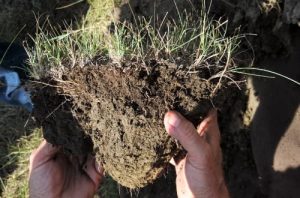What are Soil Enzymes?

Photo Credit: https://www.ndsu.edu/soilhealth/?page_id=420
Soil enzymes are specialized proteins associated with microbes, humic colloids, and clay minerals. These enzymes combine with specific soil substrates (substances being acted upon) to catalyze biochemical reactions, and mainly serve to release available nutrients and energy by increasing both the decomposition rates of plant residues and the mineralization rates of nutrients. More common enzymes serving roles in soil reactions include amidase, cellulase, chitinase, dehydrogenase, glucosidase, hydrolase, phosphatase, protease, sulphatase, and urease.
Do you have an excellent resource that isn’t listed here? Submit it for consideration.
| Title | Source | Resource type and Date | Short Summary / Preview |
|---|---|---|---|
| Soil Enzymes | Soilquality.org – NRCS & others | Webpage
Sep 2011 |
Soil enzymes increase the reaction rate at which plant residues decompose and release plant available nutrients. Enzymes respond to soil management changes long before other soil quality indicator changes are detectable. Soil enzymes play an important role in organic matter decomposition and nutrient cycling. |
| Soil Quality Indicators: Biological Indicators and Soil Functions | USDA | NRCS Fact Sheet
Feb 2015 |
Soil biological indicators provide insight into the living component of the soil. Similar to physical and chemical indicators, biological indicators have a relationship to soil functions and can evaluate soil functions to assess |
| Soil Quality Indicators: Soil Enzymes | USDA | NRCS Fact Sheet
Oct 2010 |
Soil enzymes increase the reaction rate at which plant residues decompose and release plant available nutrients. |
| Title | Source | Resource type and date | Short Summary |
|---|---|---|---|
| Video protocol for enzyme analysis | JoVE from Colorado State University researchers | How-to Video
2013 |
Video explains how enzyme activity is assayed and how to interpret it. |
| Soil Enzyme Activities as Indicators of Soil Quality | Oregon State University | Book Excerpt
1994 |
The activity of soil enzymes can be used as an indicator of soil health and quality. |
| Title | Source | Resource type and Date | Short Summary |
|---|---|---|---|
| Methods of Soil Enzymology | Soil Science Society of America | Book
2011 |
Methods in Soil Enzymology provides the first comprehensive set of vetted methods for studying enzymes in soils. Main topics include activity assays, enzyme extraction, and synthetic enzyme complexes. |
| Soil enzyme activity: a brief history and biochemistry as a basis for appropriate interpretations and meta-analysis | Biology and Fertility of Soils | Peer-Reviewed Publication
Jan 2018 |
Today, many papers are being published that use methods that either do not follow exact protocols as originally vetted in the research literature or individual labs use their own method that has not been optimized for pH, co-factors, substrate concentrations, or other conditions. |
| Enzyme activities as a component of soil biodiversity: A review | Pedobiologia | Peer-Reviewed Publication
Jun 2005 |
Soil enzyme activities are the direct expression of the soil community to metabolic requirements and available nutrients. While the diversity of soil organisms is important, the capacity of soil microbial communities to maintain functional diversity of those critical soil processes through disturbance, stress or succession could ultimately be more important to ecosystem productivity and stability than taxonomic diversity. |
Last reviewed 11/12/19